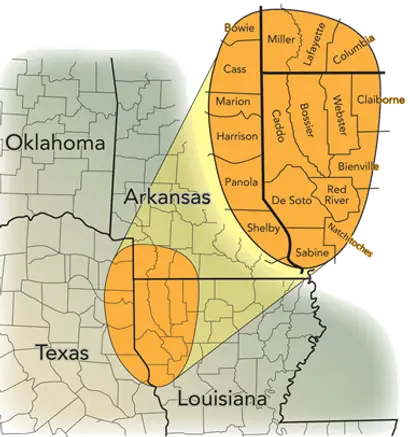There are a lot of factors that go into this answer, more so than any other area we focus on at Venergy.
Minerals and royalties can be worth a lot more than you think or they can be a lot less depending on two major factors:
- The operator and their timeline for development
- The stage of development your minerals are in. (Find out your stage.)
- The gas marketing contracts operators must negotiate and abide by
The Haynesville Shale is composed of mostly natural gas and since 2008 has been and continues to be a solid performer in the production of natural gas.
Depending on the area of your interest(s), offers are still going strong because natural gas is a clean and in-demand form of energy.
There is a lot of activity going on here and the counties in Texas we are seeing growth include Harrison and Panola. The counties in Louisiana are: Caddo, DeSoto, Sabine, Bossier, and Red River.
Remember, selling a portion of your interests could be a smart move if you need to respond for any life event. Venergy is here to answer your questions about the state of oil and gas in this prolific area.
The History of the Haynesville Shale

The Haynesville Shale gets its informal name from the town of Haynesville in Claiborne Parish, Louisiana. The total area of this great reservoir underlies large parts of southwestern Arkansas, northwest Louisiana, and east Texas.
The core, or “sweet spot” is considered to be on the Louisiana side of the shale where the majority of horizontal drilling has taken place since the first well was drilled in 2008.
Thanks to the late Aubrey McLendon and improved technological advancements in hydraulic fracturing, or “fracing”, operators were able to bust open this sleeping giant of a reservoir making it economic and cost-effective to extract this precious natural gas we rely on today. It was also wild man Aubrey McClendon who pushed lease bonuses to astronomical heights sometimes ranging in the $30,000+ range for the first time in history and not seen since.
The Haynesville Shale is a behemoth formation that underlies an area of around 9000 square miles, averages roughly 200-300 feet thick and has a true vertical depth of 10,000-14,000 feet.
When first discovered, it was thought to be the largest natural gas field in the contiguous 48 states but in 2009 the Marcellus Formation in the northeast U.S. took the title for largest gas formation.
It continues to be a stellar area for producing vast quantities of recoverable natural gas and a top pick for mineral buyers and investors.
“…the counties in Texas we are seeing growth include Harrison and Panola and in Louisiana: Caddo, DeSoto, Sabine, Bossier, and Red River.
If you need further help or just want to have conversation about what’s going on in the industry, schedule a consultation today.





Leave a Comment